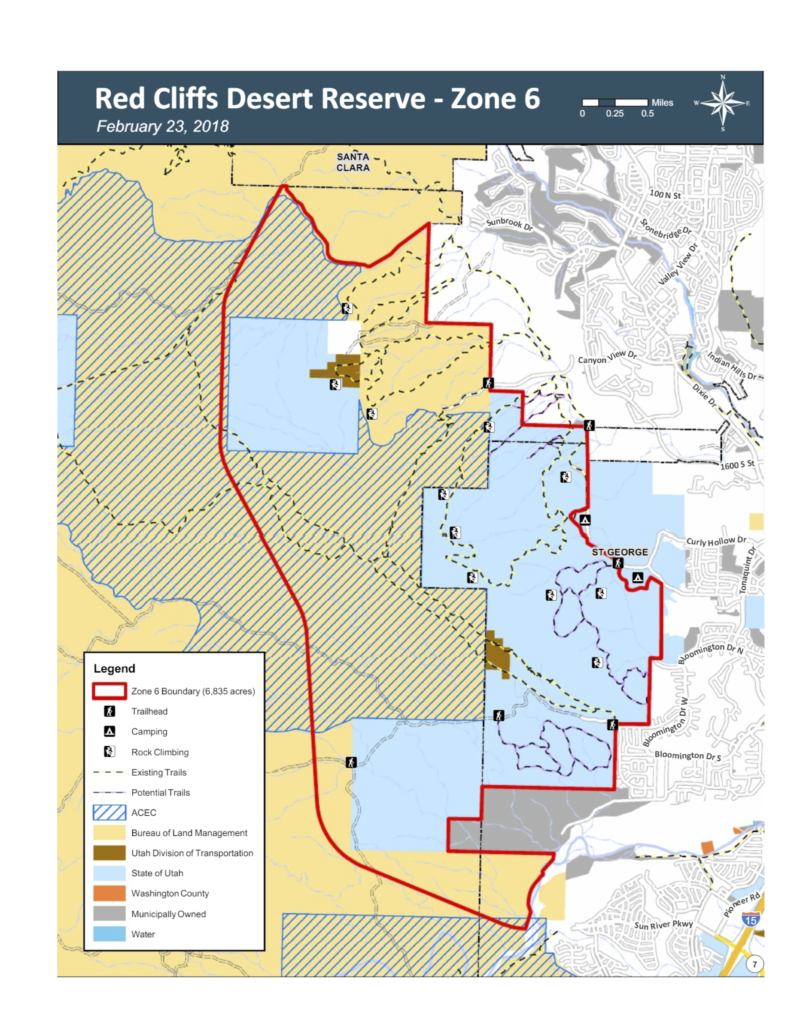What is Zone 6?
Zone 6 is a 6,800-acre tract west of Bloomington and Sunbrook that spans a diverse mix of land managed by both the Utah Trust Lands Administration (UTLA, formerly SITLA – State of Utah School and Institutional Trust Lands Administration) and the Bureau of Land Management. Its designation includes Areas of Critical Environmental Concern (ACEC), underscoring its ecological importance.
Zone 6 is a magnet for outdoor enthusiasts and generates $ millions in economic impact.
Zone 6 contains some of the best rock climbing and mountain biking in Southwest Utah. The Bearclaw Poppy Trail Systems, Moe’s Valley, and the Green Valley Gap Area, in particular, have made it one of the most visited recreation sites in the county, with over 31,000 visits recorded in 2018 alone.
This vibrant recreational hub, frequented by hikers, rock climbers, and mountain bikers, also supports significant events like the True Grit Epic Mountain Bike Race, generating $10-12 million of economic impact to Washington County.
Zone 6 is also a key refuge for wildlife.
The area is a critical habitat for many species including the threatened Mojave desert tortoise. A 2017 survey by Washington County discovered 78 live tortoises, with an estimated density of 22.5 tortoises per square kilometer (many relocated from nearby development), indicating a thriving population similar to other areas within Red Cliffs Desert Reserve.
This significant finding suggests that Zone 6 deserves permanent protection, regardless of the highway decision.-
Zone 6 UTLA lands are not permanently protected.
Roughly half of the lands in Zone 6 are managed by the BLM and are protected in perpetuity. The other half are managed by UTLA and are unfortunately not permanently protected, even with the Zone 6 designation. We must work with local land managers, conservation organizations, and recreation groups to determine if and how the Zone 6 UTLA lands could be protected.
Stopping the highway is key to protecting Zone 6 UTLA lands.
Due to deficiencies in their 2020 environmental analysis of the Northern Corridor Highway, the BLM is currently completing a supplemental study and issuing a new decision on whether or not to approve the proposed four-lane highway through Red Cliffs NCA.
Washington County officials state that a rejection of the Northern Corridor Highway would invalidate Zone 6, placing UTLA lands at risk of development. They are using this message to advocate for approval of the highway.
We are concerned with this messaging for many reasons:
- It ignores the fact that Zone 6 UTLA lands are not currently permanently protected, even with the Zone 6 designation.
- There is no legal requirement mandating the removal of the Zone 6 designation if the highway is denied, and in fact, Washington County would need to pursue separate action to remove Zone 6 from the Reserve or to develop Zone 6 UTLA lands.
- Washington County’s Red Cliffs Desert Reserve, Conserve Southwest Utah, and many other organizations and citizens are all advocating for the extraordinary conservation and recreation values of Zone 6 UTLA lands. We all want the same thing, so instead of conflating Zone 6 with the controversial highway, let’s work together to pursue permanent protections for Zone 6 UTLA lands.
- There are currently 2 roads planned through Zone 6, and the Western Corridor is planned to hug its western edge, compromising the protections.
- Approval of the highway would set a dangerous precedent for protected conservation lands everywhere. A Zone 6 designation doesn’t mean much for conservation if a four-lane highway is allowed through Zone 3. To protect Zone 6 from development, we must first protect Zone 3 from illegal development.


